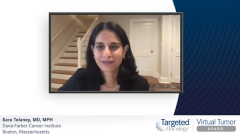
Case 1: Adjuvant Treatment for Residual Disease in Early Stage HER2+ Breast Cancer
Episodes in this series

Sara Tolaney, MD, MPH: This patient went on to get preoperative therapy. She had a tumor of 2 cm and had nodal involvement, so we wanted to give preoperative treatment. She got 6 cycles of TCHP [docetaxel, trastuzumab, pertuzumab, carboplatin] therapy and proceeded to breast surgery, where she had a mastectomy. It was found that she had residual disease. There was a 2-cm residual intermediate-grade DCIS [ductal carcinoma in situ], but there was also 0.9-cm residual invasive disease that was ER [estrogen receptor]–negative, HER2/3 [human epidermal growth factor receptor 2/3]–positive, and FISH [fluorescence in situ hybridization] amplified. She had no lymph nodes that were involved at the time of surgery, so her pathologic staging at the time of surgery was T1N0.
Ruta Rao, MD: Let’s talk about retesting receptors on residual disease. Dr Sadimin, as a pathologist, is this standard of care? Can you comment on what your institution does?
Evita Sadimin, MD: In our institution [Rutgers Cancer Institute of New Jersey], we routinely do testing on residual disease on excision and on post-treatment excision. In most cases, the results are going to be the same, but there are some cases in which it is different. Usually, when we see the difference, there is more difference in the receptor status. As reported in the literature, it’s usually 15% to 30% in difference in ER/PR [progesterone receptor], and for many patients, there is more difference in PR than in ER. The HER2 is usually similar, but we sometimes see a difference in about 10% to 15% of cases. I don’t have the numbers for our in-house cases, but it’s about the same as has been reported in the literature. Do remember that, in the resection, we have a larger area, so it may be a difference of different areas or just different expression in different areas. We need only about 10% to call something positive. If we happen to have the most negative area in the biopsies, and in the resection, we have the remaining area that is positive, then it would be different. In this case, the IHC [immunohistochemistry] was equivocal 2+ on the initial and 3+ on the excision, and the HER2 status was amplified.
Ruta Rao, MD: Should we use the HER2 expression level at the baseline or the HER2 status on the surgical specimen with the residual disease as our factor in decision-making? Dr Tolaney, how would you answer that question?
Sara Tolaney, MD, MPH: Generally speaking, I’m using the HER2 expression at baseline to guide my treatment recommendation with the idea being that, if the patient is HER2-positive, then we want to be giving HER2-directed therapy. If they lose HER2 expression at the time of surgery, which we see in about 15% to 30% of cases, then it is interesting that there are some prognostic data suggesting that loss of HER2 is associated with worse outcomes from a few retrospective series that have been done. Interestingly, more recent data from the KATHERINE trial found that, in those patients who had discordance where they lost HER2 at time of surgery, it appeared that those patients still derived benefit from T-DM1 [trastuzumab emtansine]. It seems that regardless of the loss of HER2, we still would administer adjuvant T-DM1 [trastuzumab emtansine] to that patient. It’s the baseline HER2 that’s driving that decision.
Ruta Rao, MD: Great. Dr Jhaveri, would you order any additional work-up for this patient at this point, knowing that she has residual disease?
Komal Jhaveri, MD, FACP: At this point, there’s no rule for any additional work-up. When we think about systemic staging, we do that up front. Because we also look at the expression levels from baseline as we do for neoadjuvant chemotherapy patients, if there’s a need for systemic staging, we do that up front, and the residual disease doesn’t change our systemic staging work-up or necessitate any additional imaging to do something more. It is more about how we approach and adapt given the KATHERINE data in this setting where patients have residual disease.
Ruta Rao, MD: What would be your next step for this patient?
Komal Jhaveri, MD, FACP: Based on the compelling data from the KATHERINE trial, where patients with residual disease were treated with either T-DM1 [trastuzumab emtansine] or trastuzumab, there was a statistically significant improvement in the invasive disease-free survival and an absolute improvement of 11% from 77% to 88% favoring T-DM1 [trastuzumab emtansine], so I would offer T-DM1 [trastuzumab emtansine] to this patient at this point.
Transcript edited for clarity.














































